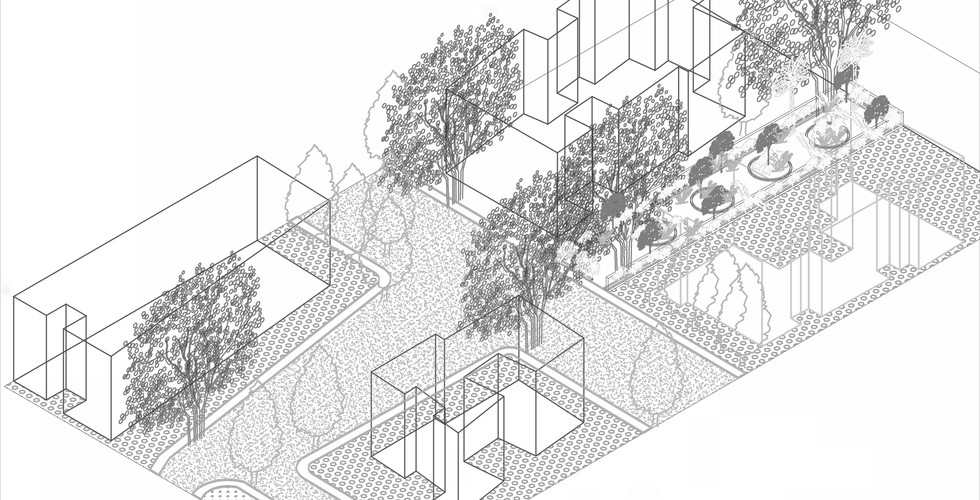Typology and Space Syntax module
- Sanjeeta Patil
- Jun 20, 2022
- 6 min read
Updated: Feb 8, 2024
Studio Co-ordinators:- Anuj Daga, Dushyant Asher, The Architecture Story (Deepak Jawahar and Justin De Penning), Sagarika Suri.
-Sanjeeta Patil
Contributions: Vatsal Visharia, Gauri Shinde, Harsh Shah, Sharvin Jangle
The main aim of this module was to familiarize the students with the concept of Type and Space Syntax in architecture and equip them with the tools to identify complex environmental issues and translate them methodically within the spatial design process. The studio introduced ways in which observed practices may be interpreted into spatial syntaxes, in other words, a “grammar” of architectural design. These grammars are deployed towards devising contemporary typologies of habitation.
The prolonged living with the COVID-19 virus has brought deep spatial reconfigurations and social implications. Recurring lockdowns over the last two years to contain the spread of the pandemic has forced us within the limits of our home. At the same time, a range of facilities are revisited, revised and freshly created in order to address the pressing health and social needs.
Several large spaces within our own neighborhoods are converted into quarantine centers, private premises are installed with cleansing equipment, institutions have strict protocols and most public facilities are simply shut. Community halls and social organizations within neighbourhoods have extended their premises to bolster the already overflowing health infrastructure. The patterns of everyday life for a large population have strictly gotten inscribed within the boundaries of the home, while those who do not have one fail to find even a stop-gap shelter.
This studio focused of critically observing the revised practices of everyday life during the course of the pandemic and purpose safe and humane extensions for physical, social and health infrastructure within localized conditions, in turn articulating what we loosely call a “pandemic type”. This space shall address the issues of distancing and intimacy, displacement and gathering, shelter and homelessness, distribution and containment within its respective locality through its architecture. We closely studied the new practices and spatial exigencies of the pandemic and attempted to create a localised facility that may extend as a temporary shelter, centre, public infrastructure or even an information hub. The site for the project was to be identified within a one-kilometre radius of one’s location, ideally an extension to an existing community facility. The project shall cater to not more than 20-25 people at any given time. In a pandemic-free future, the facility is expected to become a public space that may take newer roles as an open-source infrastructure for the neighborhood.
In the following projects, we have identified different revised practices and spatial reconfigurations in their localities and designed a project responding to these observation and analysis, while also thinking about its use in the post pandemic/ Covid-free future:-
FOOD PARK
Vatsal Visharia observed and studied the change in the usage of space and in the give and take interactions in the retail market. He observed many altered practices such as mobile vegetable shops, changes in the workspaces for shops and usage of varied methods by the shop owners to keep the shop open/ working even during the pandemic.
The site chosen was the Viviana mall in Thane West, which was located within a 1km radius of his house. He chose the edge of the mall as a site of intervention. This altered practice of cloaking space and change in the workspace of shops became the syntax for his design which he anchored to develop his design.
The main intention of his design was to design an extension that will act as a plug into the existing building that can function even when the mall is closed; a cloaking space as in a mall being also used as a takeaway centre along with other essential shops being open along with the hypermarket, where shops expand and contract according to the usage.
The concept of scaffolding and different plinth levels used in the design is extracted from his previous observations. He went through a process of numerous site diagrams and iterations, the design overview shows how things are coming together.
In his design, steel slabs infuse with the edge of the mall, the plinth of one shop becoming a shelf for the other and the shelf of one shop acting as a roof for another. These shops include a medical and general store, ATM, a cafe and stalls selling eatery products.
The sections give an idea of how the plinth levels come together and function to make this design work.
After covid, this design can become a public space, like small pockets having different public experiences. These can also become an extension to the mall as a place to loiter around like they used to do earlier in hypermarkets, before covid.
Vatsal Visharia
DEPOLYABLE SCISSOR EXTENSIONS
Gauri Shinde observed the practices around the Tuljabhavani temple, located in Tuljapur, Maharashtra. According to the Lockdown guidelines, all pilgrimages and temples were closed down for the time being. But this temple is a prime pilgrim spot and the major financial source of the town. With the temple closed, the people of this town faced a lot of economic crises.
Revised practices observed were shops on temple street started partially opening as few pilgrims visited the temple though it was closed. These shop extensions were covered with tarpaulin or fabric for partially opening. And due to these practices design syntax turned out to be the deployable scissor mechanism structure acting as shop extensions which can be closed and opened at different angles. This mechanism allows certain possibilities such as opening, closing and partially opening the shops. This intervention can also propose extensions behaving as a canopy on the same street as the deployable structure is covered with translucent lightweight fabric.
After the pandemic, it can also be used as a waiting area for pilgrims, when there are festivals and the temple area is overcrowded.
Gauri Shinde
SLEEPOVER GARDENS
Harsh Shah selected the area of a BMC garden between two residential buildings in Milan Subway, Santacruz West, as his site. He observed an altered practice of people accumulating informal spaces around streets during nighttime due to lack of space in their homes which dwelled in the nearby informal settlements. He also observed the change in the routine of the residential people, mostly their walking routines and relaxing time. This altered practice of spilling over homes and changing routines became the syntax for his design. He developed this syntax to create a space that provided the programs of changing the routine of space, sleeping space at night for the sleepover and a leisure space during the day.
The selected site had overgrown vegetation, which led to the site being unused. The idea of providing beds for nighttime sleepovers initiated his design process. These beds included resting/ sleeping beds along with flower and roof beds. Hence, to integrate and make these different concepts work together he advanced with the idea of using different plinth levels for his design. Later, walking and seating levels were also added to his design.
Overall the design has two elements, the plinth and the trellis roof, forming a different syntax that changes the experience of the garden.
Daytime it functions as a garden and during the night it becomes a sleepover space. The design provides the convenience of attaching a mosquito net for the sleepover people.
All in all this project aims for the simultaneous use of night for sleeping and enjoying the night and even staying awake in the darkness and enjoying the night.
Harsh Shah
GAME OF MUSICAL CHAIRS
Sharvin Jangle’s project titled the Game of musical chairs, as exciting as it sounds the project itself has a very unique approach. The site he observed was a market street located in Versova, Mumbai. The whole spine of the street has shop fronts on both sides, usually decorated with items for sale.
Due to covid, the shops opened for a limited time; which allowed the vendors and sellers to use the permanent shopfronts and threshold spaces as temporary shops.
He observed a pattern where the people and things kept shuffling and rearranging synonymous with a game of musical chairs which became a syntax for his design. Shops opened in the morning, temporary sellers took over in the afternoon, and at night it transitioned into a sleeping space. Plastic crates are a habitual object for street vendors, they used them to make their own little shops, the temporality thus depended on how these plastic crates were stacked, in turn making the structure mobile or stationary. The design idea was based on the concept of stacking and connecting. The design was basically a set of elements which had their own function, but when came together created multiple functions thus accommodating the multiplicities of the street.
These elements were made by observing the patterns in the positions of the people on the street, the duration, and also added elements which induce play. Throughout the day these elements can be used to create multiple combinations and configurations, but when it’s not in use it could be stacked together to create a monolithic structure which fits beside the shopfronts thus not obstructing the activities. The design was thought of as playful colourful modules spread throughout the streets which accommodate the large game of musical chairs. This module helped me to learn how to observe better, and how these observations and patterns could then result in a design.
Sharvin Jangle
This being the first module of the second year for the batch of A20, the student understood how the actual design process works. From observatory actions and site selection to creating programs accordingly and then creating design syntax for it. Site selection is the most important aspect as the site constraints themselves help in shaping the design annexe and the understanding of syntax. Students learned how to use drawing as a medium not only to convey and communicate but also to think through it!











































































Comments